These Quinoa Bagels are easy 4-ingredient gluten-free bagels packed with proteins from raw quinoa. They are soft and delicious, like a sweet or savory bagel for breakfast.
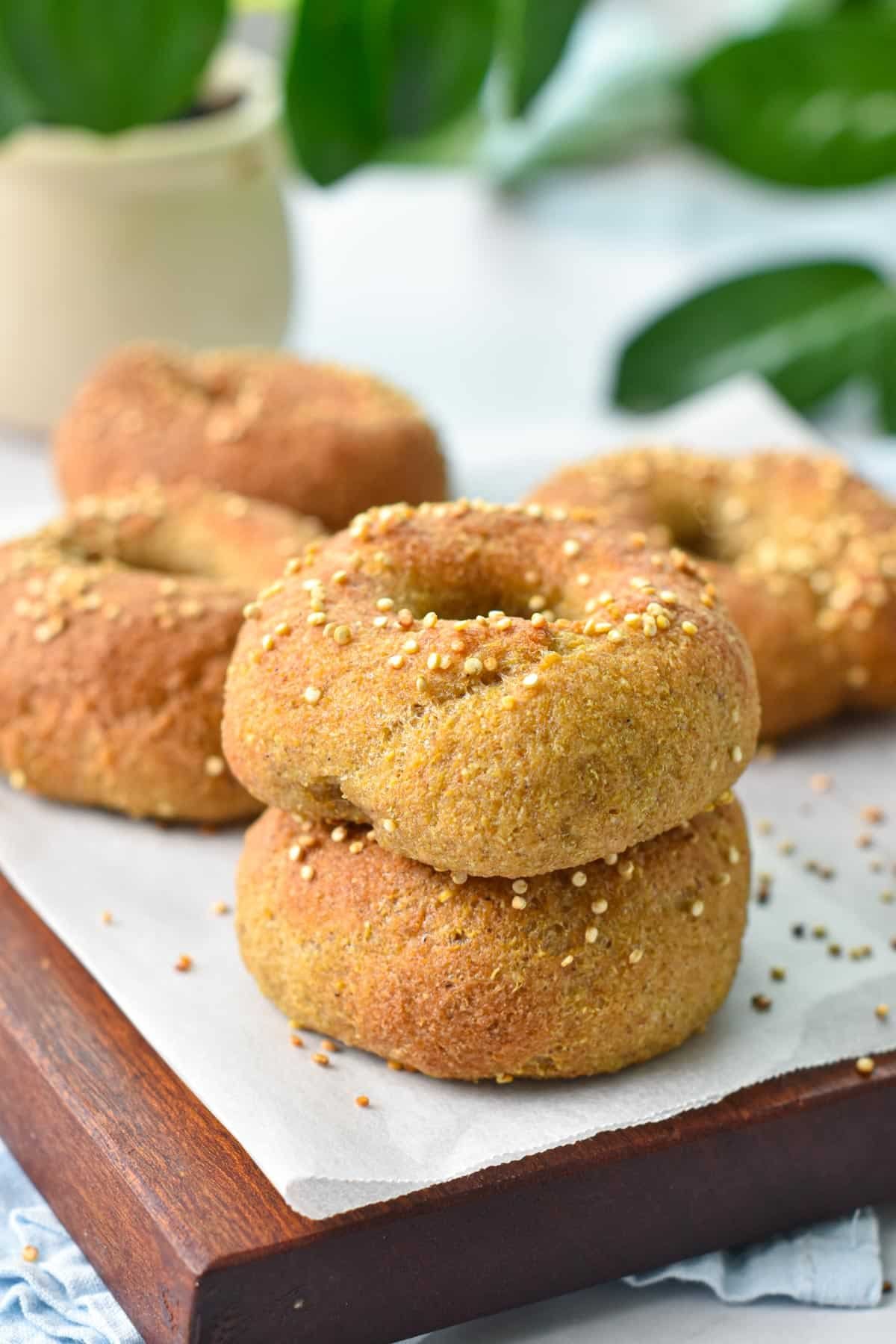
I love baking with quinoa. it’s fun and healthy and I had great success making quinoa tortillas or quinoa pancakes. That’s why I got inspiration to create a recipe for quinoa bagels. To make the bagels bouncy, and chewy, I use psyllium hush ingredients I knew would work because I used it in my vegan keto bread.
Then, I blended quinoa and water, like in my quinoa tortilla recipe and the result was amazing. Soft, bouncy chewy bagels packed with 4 grams of fiber and 4 grams of proteins.
Ingredients and Substitutions
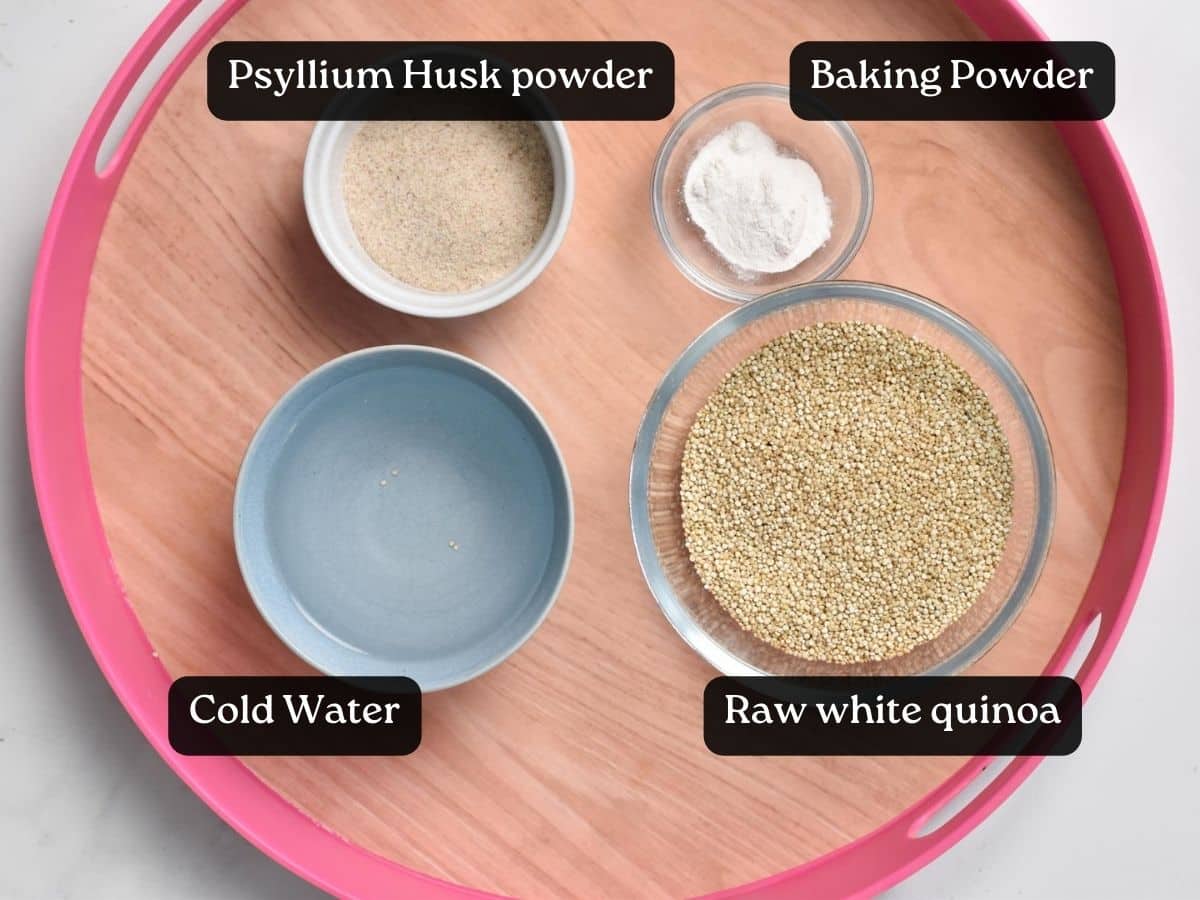
- Raw Quinoa – Any color, but keep in mind that red quinoa will turn the bread reddish. That’s why I prefer white quinoa for this recipe.
- Water – Cold water from the tap or lukewarm water, it doesn’t matter too much.
- Baking Powder to raise the bagels a little bit. Make sure you use gluten-free baking powder if needed.
- Psyllium Husk Powder – This is a crucial ingredient in this recipe. First, you can’t substitute these ingredients for anything else, like flaxmeal or chia seeds, or the bagels won’t be chewy and bouncy. Next, you must buy 100% husk powder, not a brand made of only 50% husk like Metamucil. Metamucil is a food supplement not made for baking. Finally, be aware that sometimes husk and baking powder turns food with a blue hue, and this just a natural reaction, the food is safe to eat.
How To Make Quinoa Bagels
- Line a large baking sheet with parchment paper. Lightly oil the paper with cooking oil spray. Set aside.
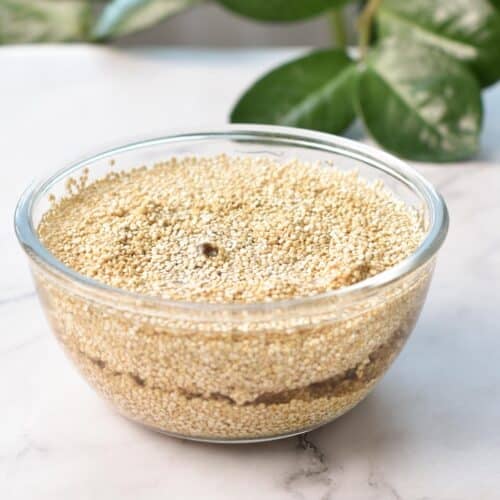
- In a bowl, add raw quinoa, cover it with cold water, and let it soak at room temperature for at least 2 hours but overnight is ideal.
- Drain over a sieve, rinse with cold water, and place in a high-speed blender with the water.
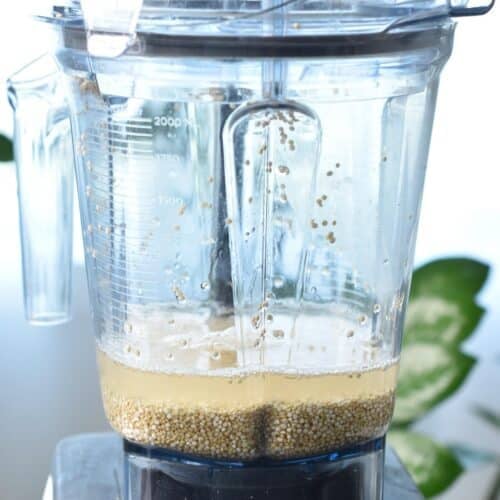
- Blend on high speed – speed 10 of a Vitamix – for 1 minute or until the mixture is lightly thick and white with gritty pieces of quinoa.
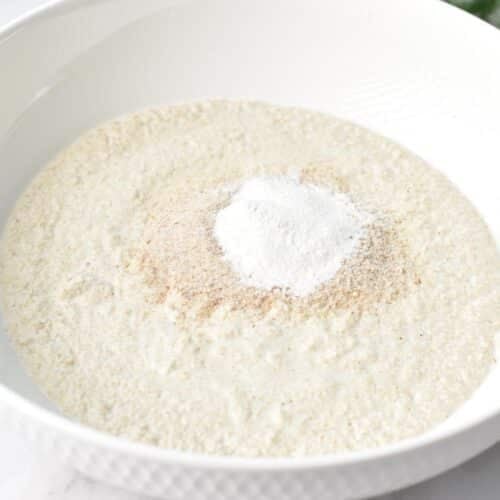
- Pour the mixture in a large bowl, add baking powder and psyllium husk powder.
- Stir with a rubber spatula for 1 minute. As you stir the fiber from husk absorb the water and turn the dough thicker and thicker. Cover the bowl, and let the batter rest for 25 minutes at room temperature.
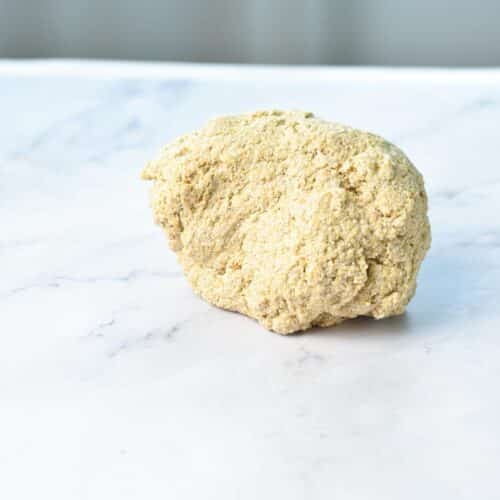
- After that time the batter is firm, and sticky, but you should be able to form a dough ball. Oil your hands generously with olive oil and rub the dough ball with your oiled hands.
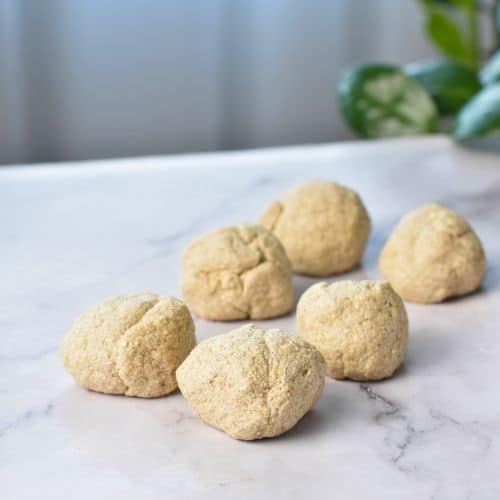
- Divide the dough into 6 portions and roll each into a ball with oiled hands.
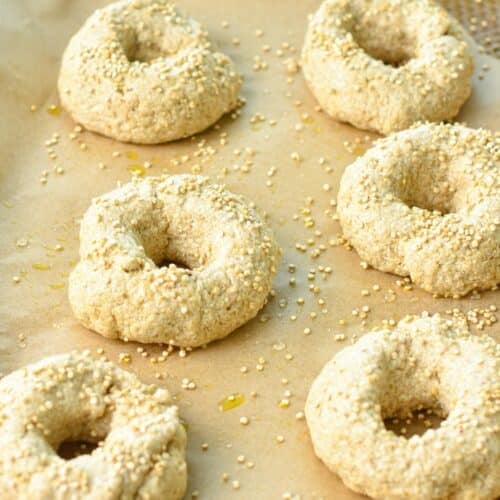
- Press the center of the dough ball with your thumbs to form a hole and place each bagel on the prepared baking sheet leaving a thumb space between each.
- Use a pastry brush to brush the top of each bagels with water and sprinkle extra raw quinoa, or bagel seasoning on top.
- Bake the bagels at 400°F (200°C) on the center rack of the oven for 25 to 30 minutes until golden brown.
- Stop the oven, keep the bagels in the oven, open the oven door wide, and let the bagels cool for 15 minutes in the oven.
- Then, let them cool at room temperature on a cooling rack.
Expert Tips
To make perfect quinoa bagels every time, follow these three easy tips.
- Do not use Metamucil. It’s not for baking and is not 100% husk.
- Don’t swap the husk powder for whole husk or something else.
- Do not use a food processor. It’s not strong enough to blend the quinoa.
Serving
Serve the bagels with sweet or savory toppings like:
- Raw vegetables, like cucumber, baby spinach leaves, shredded carrots, or avocado slices.
- Vegan cottage cheese
- Baby jam
- Date caramel
- Banana slices
Storage Instructions
You can store the bagels in an airtight container at room temperature for up to 3 days or freeze them in freezer bags for up to 1 month.
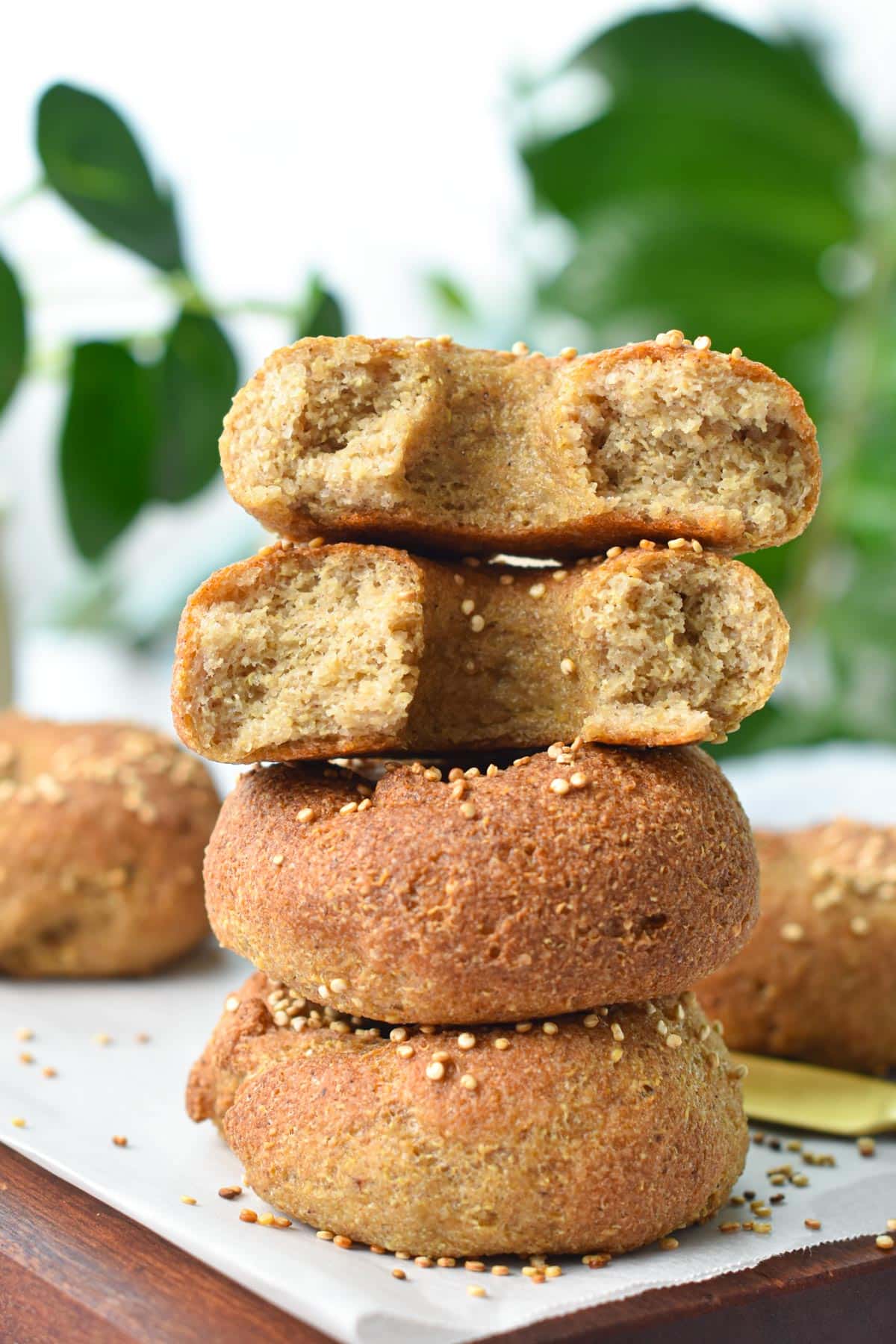
More Healthy Baking Recipes
Did You Like This Recipe?
Leave a comment below or head to our Facebook page for tips, our Instagram page for inspiration, our Pinterest for saving recipes, and Flipboard to get all the new ones!
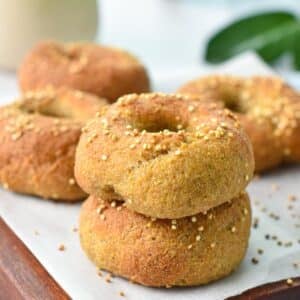
Quinoa Bagels
Ingredients
- 1 cup Quinoa - raw, uncooked, white or any color (note 1)
- 1 cup Water
- 1 ¼ teaspoon Baking Powder
- 2 tablespoons Psyllium Husk Powder - Not Metamucil! (note 2)
To work the dough
- 1-2 tablespoons Olive Oil
Instructions
- Line a large baking sheet with parchment paper. Slightly oil paper with cooking oil spray. Set aside.
- In a bowl, add the uncooked quinoa, and cover with cold water. Soak for 2 hours or overnight at room temperature.
- Drain quinoa over a sieve, and rinse quickly under tap water.
- Place the quinoa in a high-speed blender (the recipe won't work in a food processor or low-speed blender). Add water and blend on high speed for about 1 minute until the mixture is almost smooth. You might see a few gritty spots of quinoa, that's all.
- Pour the liquid into a mixing bowl and add psyllium husk powder and baking powder.
- Stir with a rubber spatula for 1 minute. As you stir, the mixture changes a lot in texture. It's liquid at first and firm up, dry out as you stir.
- Cover the bowl with a towel and set aside for 25 minutes at room temperature.
- Remove the towel. The batter should be firm and sticky but form a ball easily.
- Preheat the oven to 400°F (200°C).
- Oil your hands and the dough bowl with a tablespoon of olive oil.
- Divide the dough into 6 even portions. Roll each with oiled hands in a ball and press the center of the ball with your thumb to form a hole.
- Place each bagel on the prepared baking sheet and add a metallic piping bag nozzle in the center of each bagel to prevent the hole from shrinking back in the oven.
- Brush the top of each bagel with water and sprinkle some extra quinoa or bagel seasoning.
- Bake the bagels at 400°F (200°C) on the center rack of the oven for 25-30 minutes until golden brown.
- Stop the oven, keep the door of your oven open, leave the baking sheet and bagel in the oven, and let them cool down on the baking sheet in the oven for 15 minutes. It prevents them from deflating. Then, transfer them to a cooling rack at room temperature.

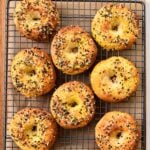
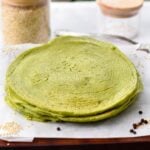
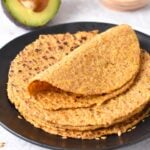
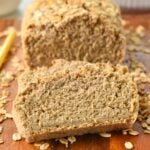


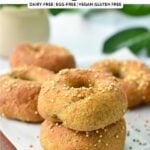
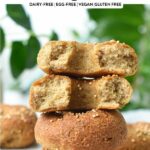
Hi,
It is not clear how much water to add to the quinoa when blending.
Can you please specify?
1 cup! It’s the place where the water is an actual ingredient in the recipe, as opposed to the water used to rinse that doesn’t need to be measured!
Is there a substitute to psyllium?
Unfortunately no, this is your binder!
How could I replace the psyllium husk?
Unfortunately no, this is the magic ingredients that makes the bagels perfect!
Hi! Is there something I could substitute to work the dough instead of oil?
I haven’t found an alternative to oil that is still easy and doesn’t alter the texture of the bagels.
Loved them – easy, tasty, great to grab as a quick snack
Wow, that was suprisingly good. I’m not a huge fan of quinoa normally, but that was real good.
They are quite soft, and even though they don’t have the same crispy crust as normal donuts, I really enjoyed them.